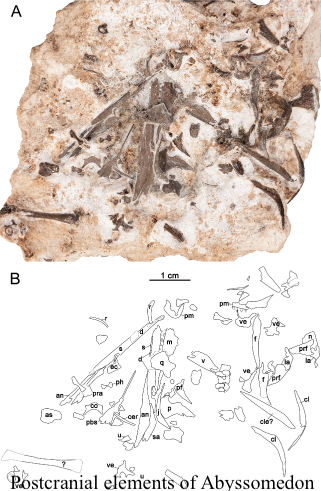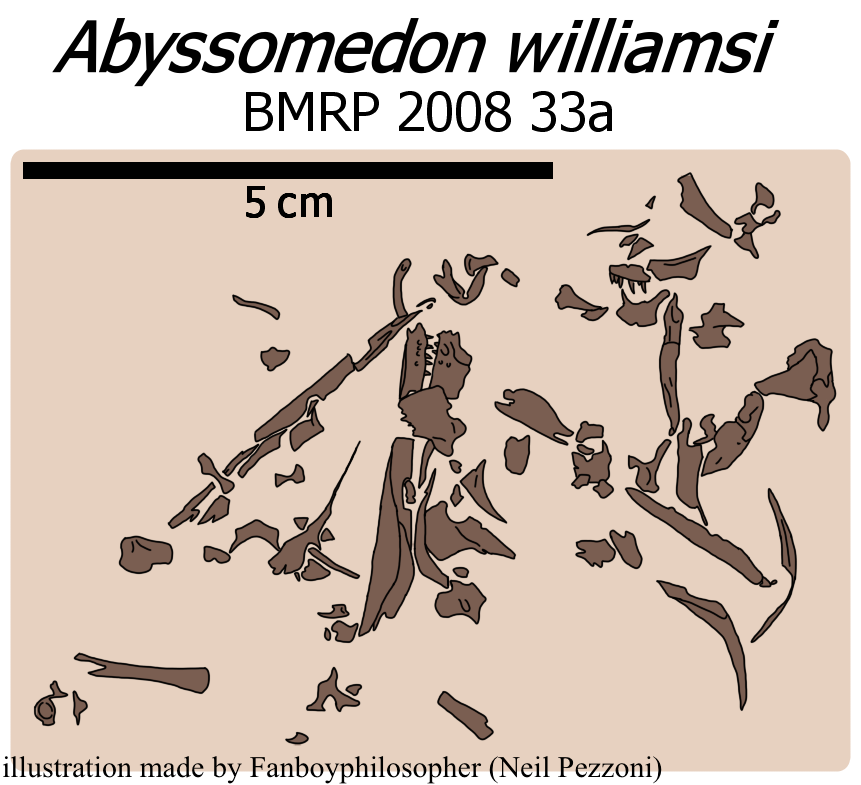Welcome to Abyssomedon

Name Definition
Guardian of the deep pit/abyss
Name Given By
Mark J. MacDougall and Robert. R Reisz in 2014
Location
Richards Spur in Comanche County, Oklahoma, U.S
Classification
Reptilia, Parareptilia, Procolophonomorpha, Nyctiphruretidae
Size
unavailable due to lack of remains
Temporal Range
Artinskian age of the Cisuralian epoch (early Permian), approximately 289 million years ago
Ecological niche
Because it is most closely related to Nyctiphruretus, Abyssomedon was probably also a small herbivorous reptile
Species/Sub Species
A. williamsi
Diet
Possibly similar to Nyctiphruretus, Abyssomedon would have also consumed aquatic plants which would have most likely been the bulk of its diet
Introduction
Abyssomedon is the oldest genus of nyctiphruretid parareptiles discovered in North America and they lived during the early Permian. Abyssomedon derives from the Greek word Abyssos which means “deep pit” and the word medon which means “guardian”, so Abyssomedon translates into “Guardian of the deep pit/abyss”. This is in reference to the cave system found at the Richards Spur fossil locality. The species name, williamsi, honors Burpee Museum paleontologist Scott Williams who originally collected the holotype of Abyssomedon.
Abyssomedon is only represented by its holotype which is a fragmentary skeleton that is currently housed in the Burpee Museum of Natural History in Rockford, Illinois. The holotype consists of a semi-articulated and partial skull which was disarticulated with the rest of the skeleton but is still considered associated, as well as some postcranial remains. The Abyssomedon holotype was discovered in 2008 at a claystone and conglomerate nodule found in the fossil locality Richards Spur. The fossils of Richards Spur are from Early Permian fossil fissures in Ordovician age limestone.
Of all the procolophonomorphs, it seems Abyssomedon is most closely related to the other procolophonomorph genus Nyctiphruretus, and since they are sister taxa, they have created the procolophonomorph family Nyctiphruretidae, whose type genus is Nyctiphruretus. The family Nyctiphruretidae is sister taxa with the superfamily Procolophonoidea, a group of small and stocky lizard-like reptiles, which further splits into the family Owenettidae and the sister family Procolophonidae.
The Richards Spur Formation provides a plethora of Permian paleofauna such as lepospondyl species (Lepospondyli consists of many salamander like amphibians, though some are much bigger), seymouriamorphs (seymouriamorphs are biologically considered as amphibians, though they have many reptilian features too and are adapted to life on land, making them very primitive reptiles or reptiliomorphs), basal synapsids (synapsids consist entirely of mammals and all vertebrates that are more closely related to mammals instead of birds or reptiles), basal eureptiles (Eureptilia consists of all modern day reptiles, birds, as well as a large amount of primitive forms from the Carboniferous and Permian that were classified as anapsids), as well as many other parareptiles besides Abyssomedon such as the basal form Microleter mckinzieorum, the bolosaurid parareptile Bolosaurus grandis, as well as the lanthanosuchoid parareptiles Colobomycter pholeter, Delorhynchus priscus, Delorhynchus cifellii, and Feeserpeton oklahomensis.
Sources:
- https://en.wikipedia.org/wiki/Abyssomedon
